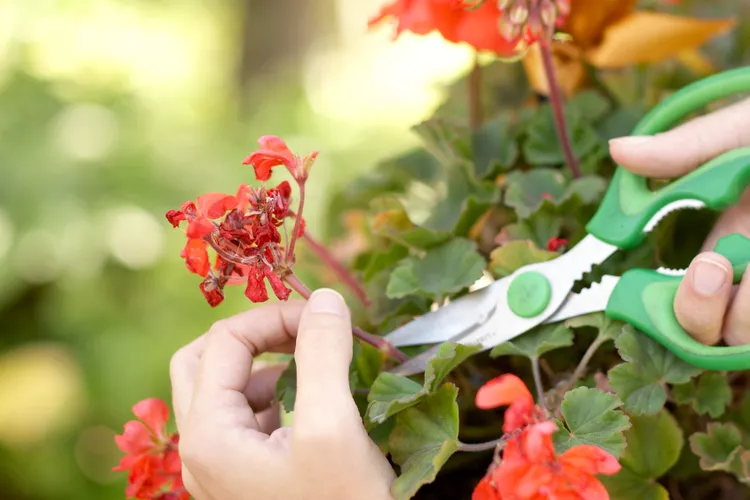How to Deadhead Geraniums to Keep the Flowers Coming All Summer

Learning how to deadhead geraniums is a snap. Deadheading is simply removing the old, fading flowers from a plant. While it's not absolutely necessary to do, this technique has two main benefits. Deadheading all types of geraniums helps maintain their appearance and encourages more blooms in your garden pots and planters. Here's what you need to know about why, when, and how to deadhead geraniums.
Why to Deadhead Geraniums
Despite our preferences, plants don’t make flowers to please us–it’s part of their lifecycle. A plant flowers to reproduce itself. Flowers contain the reproductive parts and pieces (stamen, pistil, ovule, pollen, etc.) necessary for pollination and subsequent formation of seeds. For many plants, once they’ve successfully created seeds for the next generation of their species, they stop flowering, and put their energy into forming those seeds.
Seeds are little packages containing embryos for the next generation. A lot of resources are used to make those seeds, and it takes away from energy used for growing or further flowering. Some plants may even die completely after forming seeds. We don’t want that–we want more flowers!
Deadheading is an effective technique because it frustrates the plant's seed-making mission by removing flowers that are no longer pretty before the plant can create the seeds. Because the plant was thwarted at making seeds, it tries again with another flower. Eventually, at the end of the season, we can let it go to seed or not, depending on our goals. Removing the spent flowers from your geraniums encourages them to continue flowering and keeps their appearance tidy.
The geraniums we grow as annual flowers are actually members of the Pelargonium genus, and all parts of the plant are toxic to dogs and cats. Take care that your pet isn’t grabbing those discarded flowers for a treat.
When to Deadhead Geraniums
Once summer arrives and flowering begins in earnest, many geranium blooms will be open at once, but not all are ready to be removed simultaneously. A geranium flower head is ready to be deadheaded when it starts to fade and drop petals. It won’t look fresh and new like a flower head at its peak but instead will look worn and withered.
How often to deadhead your geraniums varies with the weather. Hot and dry conditions or storms can cause blooms to look faded and tattered faster. Barring extreme conditions, checking once or twice a week for flowers to deadhead will suffice.
Steps for Deadheading Geraniums
Deadheading geraniums is easily achievable in a minute or two while you enjoy a morning cup of coffee or putter around your garden after work. Well, unless you have tons of geraniums, in which case you may need to tackle a few one day and a few more the next. To correctly deadhead the flowers from your geraniums, follow these simple steps:
- Choose a flower that is ready to be removed. It may be starting to turn brown or look tattered with some missing petals.
- Grasp the flower stalk right below the the point where all the individual blossoms in a cluster join together.
- Slide your fingers down the flower stalk until you reach the main stem of the plant.
- Twist or snap the entire stalk from the stem. It will pop off right at the node.
You can also use scissors or snips to cut off the flower stalks, but it’s easier, cleaner, and quicker to snap them off with your fingers. If you use a tool, don’t snip off the flower heads right below the petals. You’ll end up with funky-looking flowerless stalks sticking out of the plant. Always cut them off where the flower stalk attaches to a stem.
Tips for Encouraging More Geranium Flowers
While deadheading your geraniums will encourage them to continue flowering as much as possible, keeping your plants happy and healthy through the summer will give them more energy to make flowers in your garden pots and planters. The three keys to this outcome are providing the right amounts of water, light, and fertilizer.
Water
Geraniums are drought tolerant, one of the reasons they are great for containers and hanging baskets. They don’t want to be watered quite as much as many other plants. Let their soil slightly dry out between waterings. If in doubt, use your finger to test the soil. Wait to water until it feels a bit dry an inch or two down, or about to the main knuckle on your finger.
Light
Geraniums are heat-loving plants that enjoy sunshine. Most varieties will flower best in a location with at least six hours of sunlight daily. While they will tolerate some shade, they will grow slower and flower less.
Fertilizer
Geraniums grown in container gardens can be fertilized every other week with a diluted general-purpose product, following the directions on the label. Choose a slow-release fertilizer for in-ground geraniums, applying once in early summer and again later in the blooming season.